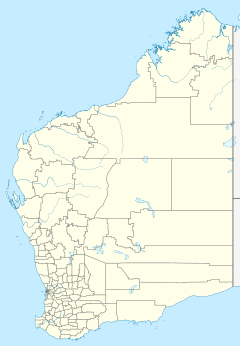Marribank facts for kids
Marribank, also known as Carrolup, is a place in Western Australia. It's about 30 kilometers (19 miles) north-west of Katanning. This site was once a special settlement for Indigenous Australians. It was one of the places where children from the Stolen Generations were taken after being separated from their families. The amazing artworks made by children at Carrolup are some of the only remaining items created by members of the Stolen Generations across Australia.
History of Marribank
Why Settlements Were Created
In 1905, the government in Western Australia passed a law. This law said that all Aboriginal or part-Aboriginal children were "wards of the state." This meant the Protector of Aborigines became their legal guardian. This person had the power to take children away from their parents.
This policy is now known as the Stolen Generations. Children were taken, especially if they had European family, to stop them from learning traditional Aboriginal languages and cultures. The government hoped that boys would learn to be farm workers and girls would become domestic helpers.
Carrolup Native Settlement (1915-1922)
Carrolup was opened in 1915. It was a government-run "native settlement." The Australian Aborigines Mission helped run it and provided volunteers. It was near Katanning. This settlement, along with others like Moore River, was a place where many Noongar people from South West Western Australia lived.
The Carrolup facility closed in 1922. All the people living there were moved to the Moore River Settlement.
Carrolup Native Settlement (1939-1951)
The settlement reopened in 1939. By 1944, it housed 129 boys and girls. In the late 1940s, drawings made by some of the children became famous around the world.
In 1949, the school at Carrolup closed. The school-aged children were sent to other places. In 1951, the settlement closed completely. The adults living there were "dispersed," meaning they were sent away. Some teenage boys stayed to start the Marribank Farm Training School.
Marribank Farm Training School (1951-1952)
This farm training school for Aboriginal boys was open for a short time. In 1952, it was given to the Baptist Church to run.
Marribank (1952-1988)
The Baptist Union of Western Australia ran the settlement as an Aboriginal mission. This continued from 1952 until 1988.
Carrolup Child Artists
How the Art Became Famous
In the late 1940s and early 1950s, Carrolup Native Settlement became known for its art. The children living there created a special Noongar (South-West Aboriginal) art style. Their paintings often showed local Western Australian scenes, especially at sunset.
Some of the famous Carrolup artists included Revel Cooper, Reynold Hart, Mervyn Hill, Parnell Dempster, Claude Kelly, Micky Jackson, and Barry Loo.
Exhibitions of their art were held in Perth and other Australian towns. With help from Florence Rutter, the art was also shown in cities like London, Manchester, Edinburgh, and Glasgow. When Carrolup Native Settlement closed in 1951, the international exhibitions stopped.
Where the Art Went
Florence Rutter had collected many of the Carrolup children's artworks. She planned to show and sell them in the United Kingdom and the Netherlands to help the children. She even set up a charity called the Aboriginal Children's Trust in London. Sadly, she lost all her money, and the Trust's money, to a con man.
She had to sell the collection to Herbert Mayer from New York City. Florence Rutter passed away in 1958.
Herbert Mayer later gave the collection to his old university, Colgate University, in New York in 1966. In 2004, Howard Morphy "found" this collection at the Picker Gallery at Colgate University. A year later, Athol Farmer, Ezzard Flowers, and John Stanton traveled to the United States. They chose pieces for the 2006 "Koorah Coolingah" exhibition in Katanning. There was also a similar exhibition at the Western Australian Museum in Perth.
New Interest in the Art (1980s onwards)
Many important Western Australian Aboriginal artists started their work at Marribank. Their art was featured in two national exhibitions. These shows helped bring new attention to Aboriginal art from the South-West.
In 1987, a community project began. Two Noongar trainees learned about museums at the Berndt Museum of Anthropology at The University of Western Australia. They were funded to help create a Cultural Centre at Marribank/Carrolup. The community wanted help from John Stanton because he was interested in the Carrolup children's drawings from 1946-1950.
The Museum had been collecting these drawings for years. Copies of the drawings, photos, and news clippings were given to the Cultural Centre. The Centre opened in 1988. The trainees learned skills like managing collections, setting up displays, and photography.
The first exhibition at the Cultural Centre showed the history of Carrolup Native Settlement. It also highlighted the "bush landscape" art style that started there. Another room displayed newer Noongar artworks. A third gallery, focusing on the Marribank years, opened in 1992.
In late 2018, David Clark and John Stanton created a website, www.carrolup.info. It helps share the story of Carrolup and its art, which spans over eighty years.
Marribank Today
After the settlement was no longer used, many of the buildings became run down. In 2016, a new project started. The goal is to turn the site into a cultural healing center. This center will help survivors of the Stolen Generations and their communities.


